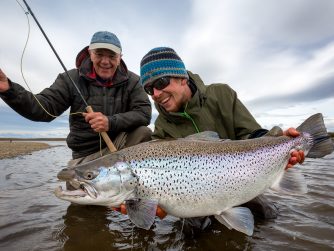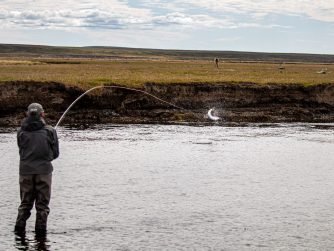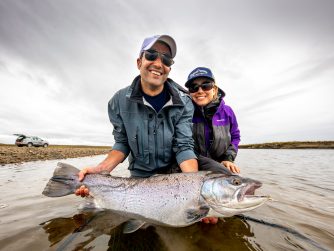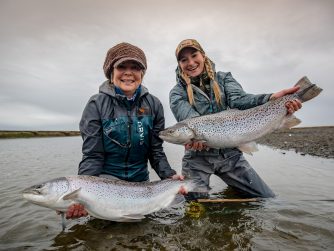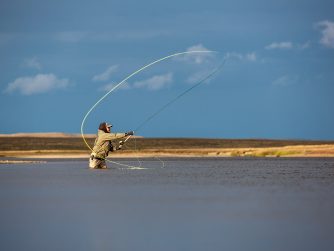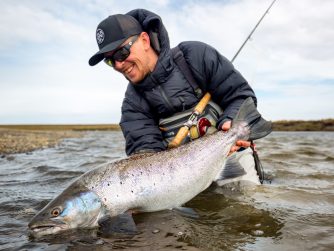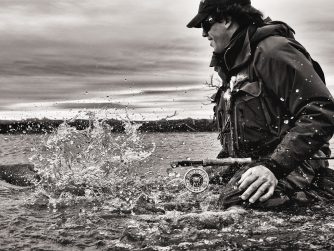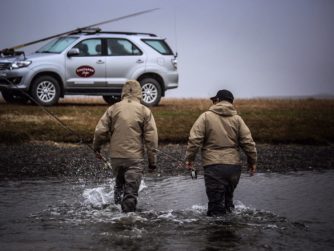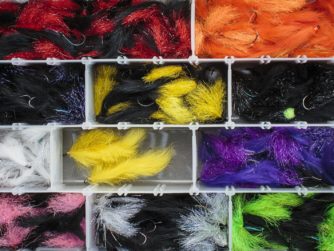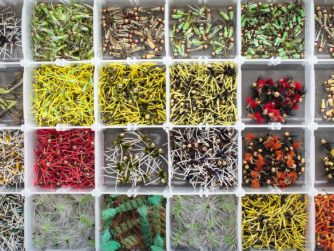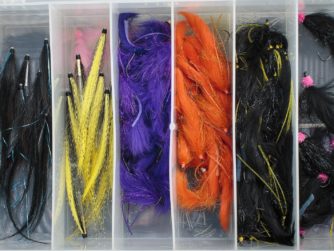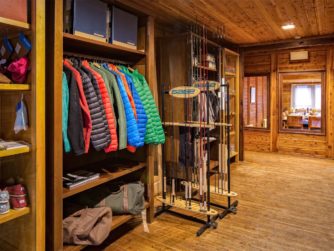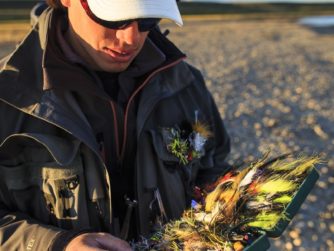Fishing the Rio Grande
Although most of their lives are spent in the ocean, sea-run brown trout seem to retain more of the eccentricities of resident browns than, for instance, steelhead do of resident rainbows. Moody fish, they must be shown flies the way they want to see them. The Rio Grande is a large river. Thus, it’s compatible with a wide range of techniques; critical since a large sea-run brown trout may demand that a fly be fed to it on the bottom one hour but rise to a skating fly the next. Water levels can change from week to week and they generally drop as the season progresses.
Vary your presentations in each pool fished until you find the right formula of fly, line, drift or swing, and retrieve. Also heed the advice of your guide, whose primary aim is to help you hook and bring more fish to the net.
Generally, the Rio Grande’s sea-run brown trout seem to lie near cut banks during the middle of the day, though in low water they will also lie in the faster necks of pools. They typically move into these areas during early morning, evening, and nighttime hours. A good rule is, “Tails in the morning and heads at night.” Also look for fish distributed throughout pools on calm, overcast days. On sunny days, one theory holds that sea-run browns take best if they don’t have the sun in their eyes, although this theory, like others, is often affected by the number of fish in a particular pool and the number of “takers.”
THE DAILY PROGRAM
Guests will leave the lodge around 9 o’clock after breakfast, fishing till around 1 o’clock. Following lunch and a siesta (the duration depends on the season), guests return to the river in the late afternoon and fish until dark. Fishing hours will change slightly depending on the time of year.
EQUIPMENT
The suggestions that follow are drawn from over two decades’ experience fishing the Rio Grande under a wide variety of conditions.
- Rods: The Rio Grande features a natural design an instream architecture perfectly suited for Spey rods. Mending and controlling line is also easier with a 2-hander. Use 7- to 9-weights from 12 to 15 feet long. If you’re new to Spey casting, our guides are expert instructors and will help you learn quickly. Lighter switch rods are increasingly popular and allow anglers to cast a comfortable line with less effort, particularly on windy days.
Single-handers in 7- to 9-weights—and up to 10 feet long—can also be effective in light-wind conditions on the Grande or for technical, close-range nymphing on the Rio Menendez tributary. Longer rods make casting easier with the normal downstream southwest wind, while an 8- or 9-weight helps you to drive your line into or across the wind when necessary. Given the Rio Grande’s moderate flow and generally even gravel bottom, you’ll find an 8 or 9 capable of doing battle with even the river’s largest sea trout (15 to 25+ pounds), while it ensures the most action with smaller sea trout (4 to 10 pounds).
Loop and Sage produce many of the best rods we use regularly on the water. In addition to a stalwart lifetime warranty, the company engineers several high-performance options perfectly suited for this fishery.
- Reels: choose a quality reel with a powerful, adjustable drag. Reels (and spare spools) should have enough capacity for your fly line and 100+ yards of 20-pound backing. We recommend reels from Sage, which produces several options well suited for the Rio Grande.
- Lines: To be well prepared for Tierra del Fuego, anglers should include at least three lines to accommodate varying water levels and wind conditions. Weight-forward fly lines are generally used on the Rio Grande.
Floating lines are most useful during low-water conditions and in the early morning and evening hours when sea-run brown trout feed near the surface. Integrated sinking tip lines also work great, while intermediate lines are also effective in some conditions.
For Spey rods, we’re mostly using shooting heads, from floating to fast-sinking (S4). Most shooting heads can also be used with sink-tips so you can target different depths. RIO AFS are easy to cast and effective, whether fished floating or sinking. RIO offers sinking poly leaders for those lines. If you’re fishing a Skagit-style set-up, also check out RIO’s MOW Tip system in varying weights and sink rates. Fish Skagit heads for easy rod loading, for casting larger flies on heavy tips, and for effectively casting into the wind. Use 400- and 700-grain heads, depending on your rod.
Even experienced anglers often find their running line snarls when buffeted by wind. Prevailing southwest winds can be “harnessed” by roll casting or spey-casting, which eliminates the need to back cast—difficult to do with a trailing wind. We found that a simple roll cast carries even large streamers 35 to 50 feet across and downstream, or far enough to cover the holding lies. Weight-forward lines can be rolled effectively by stripping and shooting line during the cast.
- Leaders: Experience on the Rio Grande indicates that sea-run brown trout are not particularly leader shy. While reasonable stealth should be exercised, your chief concern is to bring monofilament in sizes that will turn over the array of fly sizes and patterns you’ll be using. Spools of monofilament should include 10- to 15-pound test weights. While fishing sinking lines, a few feet of straight (not tapered) monofilament will do fine. Maxima Ultra-green is a good choice as it has plenty of stretch, a factor worth considering when the sea run of a lifetime hits your fly! While fishing, be sure to check your mono regularly for casting knots and abrasions. After each fish caught test your leader knots. For floating lines it’s good to have knotless tapered leaders from 9 to 12 feet, with 0X tippets.
- Flies: Plan to bring a good selection of flies, however, some fly patterns, as well as a modest supply of back-up tackle, will be available for purchase at the lodge. Sea run brown trout are mysterious fish. The only constant in their tastes seems to be a penchant for black. The trout that accepts your small Salmon patterns today may demand flies with white rubber legs tomorrow! Historically, most Rio Grande fish were taken on large streamers, perhaps because those were the patterns most commonly used. In low water conditions, more large sea trout are taken on smaller wet flies, nymphs, and drys. We suggest packing a range of flies in various patterns and sizes, and urge frequent changes when one combination isn’t working. These combinations will be determined based on light conditions, water levels, and especially on your guide’s advice. Barbless hooks are strongly encouraged. Double and treble hooks are not permitted. Catch-and-release is mandatory.
General fly list:
- Collie Dog tube flies (31/2 -41/2” long, both aluminum and copper bodies, with hard plastic tubing and #4 wide-gape hooks)
- Sunray shadow in different sizes.
- Bunny leech, Zonker, Woolly Bugger (black/olive), articulated string leech types, with electric blue flash, on #2-4 hooks
- Peacock (now a staple on Rio Grande, tied on #2-4 hooks)
- Girdle or Yuk Bug rubber legs (#4-12)
- Bitch Creek nymphs (orange and black for preference, #4-12
- Bead head nymphs (Prince, Hare’s Ear, etc. #10-14)
- Traditional Atlantic Salmon flies
- Bombers or other waking dry flies (natural deer hair, black&green on #4-8 hooks), for use drifted or with a Portland hitch
- Include 1- to 2-inch tube flies if you have them, as tubes can be effective on the Rio Grande. Also, take any large dark trout or salmon fly in which you have confidence. Fishing a fly that has worked for you in the past, and in which you have confidence in is half the battle. Note that larger streamers should be weighted and should be tied on heavy hooks with good gapes.

